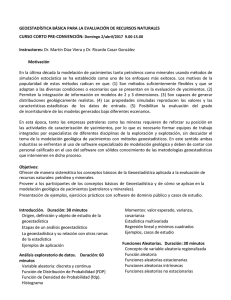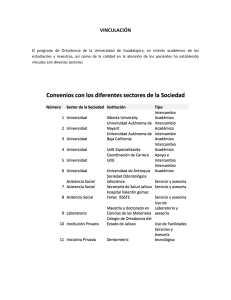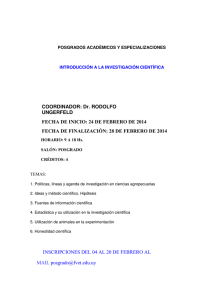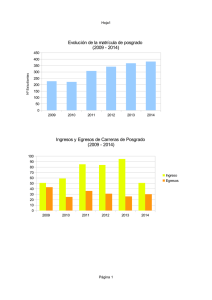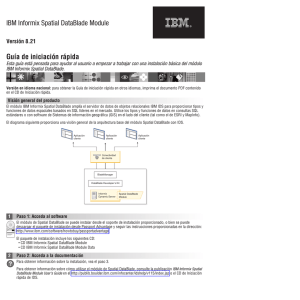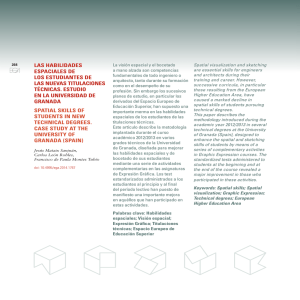GEOESTADISTICA: Aplicaciones en agricultura y ciencias medioambientales
Anuncio
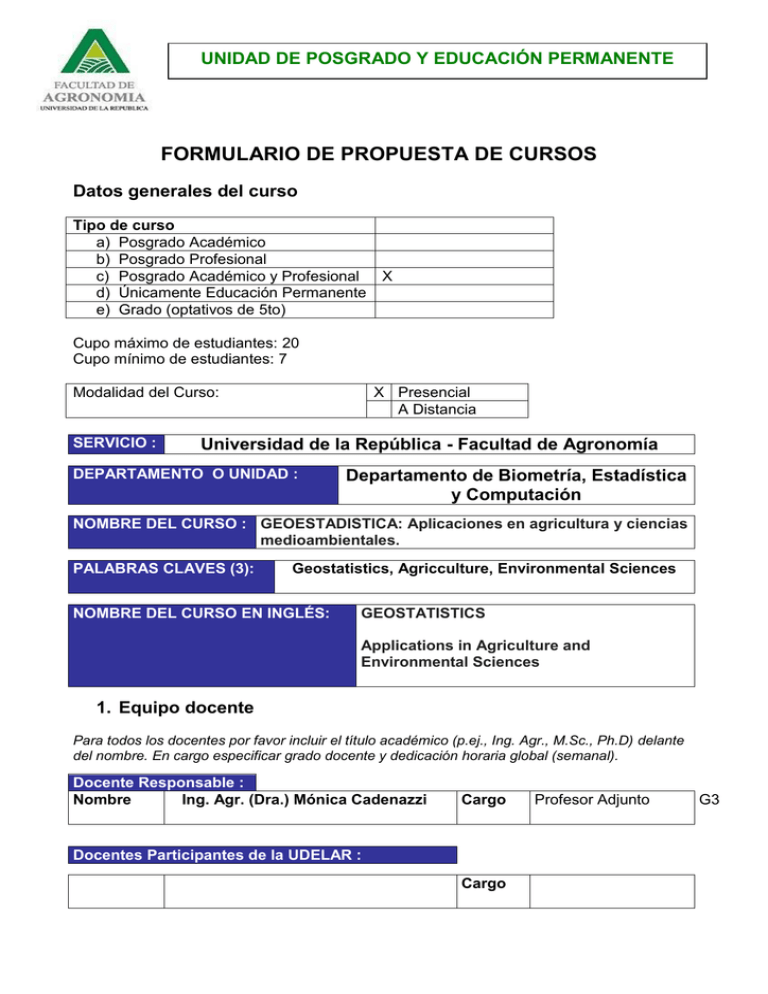
UNIDAD DE POSGRADO Y EDUCACIÓN PERMANENTE FORMULARIO DE PROPUESTA DE CURSOS Datos generales del curso Tipo de curso a) Posgrado Académico b) Posgrado Profesional c) Posgrado Académico y Profesional d) Únicamente Educación Permanente e) Grado (optativos de 5to) X Cupo máximo de estudiantes: 20 Cupo mínimo de estudiantes: 7 Modalidad del Curso: SERVICIO : X Presencial A Distancia Universidad de la República - Facultad de Agronomía DEPARTAMENTO O UNIDAD : Departamento de Biometría, Estadística y Computación NOMBRE DEL CURSO : GEOESTADISTICA: Aplicaciones en agricultura y ciencias medioambientales. PALABRAS CLAVES (3): Geostatistics, Agricculture, Environmental Sciences NOMBRE DEL CURSO EN INGLÉS: GEOSTATISTICS Applications in Agriculture and Environmental Sciences 1. Equipo docente Para todos los docentes por favor incluir el título académico (p.ej., Ing. Agr., M.Sc., Ph.D) delante del nombre. En cargo especificar grado docente y dedicación horaria global (semanal). Docente Responsable : Nombre Ing. Agr. (Dra.) Mónica Cadenazzi Cargo Docentes Participantes de la UDELAR : Cargo Profesor Adjunto G3 Especialistas invitados : Nombre Institución Prof. Ph.D Emilio A. Laca University of California, Davis Cargo Especialización Profesor Statistics Environmental Sciences Docentes Extranjeros : Nombre 2. Programa del curso DESTINATARIOS : (Indique a quien va dirigido el curso citando disciplina y especialización) The course is designed for advanced undergraduate and graduate students who are familiar with probability and linear models. The target level would be achievable by taking a graduate level course in statistical modeling, mixed models, or generalized mixed models and the corresponding prerequisites. The main point is that the student should be familiar with a modeling approach to statistics as opposed to a ANOVA/hypotheses testing approach only. OBJETIVOS: (Indique brevemente los objetivos principales del curso) The goals of the course are to: • provide an introduction to spatial statistics and place geostatistics in this context, • show typical applications of geostatistics to address practical issues, and • prepare the student for further learning about geostatistics CONTENIDOS : (Indique brevemente los principales contenidos temáticos del curso) • Introduction a. Examples b. RStudio c. R and geostat packages d. geoR and geoRglm • Types of spatial data • Uses of geostatistics • Theory of random fields a. Stationarity and ergodicity b. A multivariate distribution of a single variable • Motivating example 1: map soil organic matter content (SOM) • Motivating example 2: what determines SOM? • Brief statistical modeling concepts a. Modeling the signal b. Modeling the stochastic component • Spatial covariance and semivariance a. Estimation of semivariogram b. Positive definitness: why only certain models c. Sources of uncertainty: sample, regional and theoretical variograms • Estimation a. Parameters of the explanatory component b. Parameters of the spatial covariance function c. Example: single-field model of yield • Prediction and Kriging a. Mapping elevations b. Change of support: estimating carbon storage in soil • Design of spatial sampling a. Choosing locations for estimation of parameters b. Choosing locations for accurate prediction • Delineation of management units METODOLOGÍA : CURSOS PRESENCIALES: Exposiciones Otras (indicar cual/es) X Trabajos Prácticos X Actividades Grupales CURSOS A DISTANCIA: Video-conferencia Materiales escritos Internet X En caso de utilizar videoconferencia: Localidad emisora Localidades receptoras SISTEMA DE EVALUACIÓN (en caso de realizarse evaluación de los estudiantes) : X BIBLIOGRAFÍA : Rossi, R. E., D. J. Mulla, A. G. Journel, and E. H. Franz. 1992. Geostatistical tools for modeling and interpreting ecological spatial dependence. Ecological Monographs-62:277-314. Green, T. R. and R. H. Erskine. 2004. Measurement, scaling, and topographic analyses of spatial crop yield and soil water content. Hydrological Processes 18:1447-1465. Diggle, P. J. and P. J. Ribeiro Jr. 2006. Model based geostatistics. Springer.http://www.leg.ufpr.br/geoR/ R Core Team. 2013. R: A language and environment for statistical computing. R Foundation for Statistical Computing, Vienna, Austria. URL http://www.Rproject.org/, http://cran.r-project.org/ Ribeiro, P. J. and P. J. Diggle. 2012. geoR and geoRglm. Analysis of geostatistical data. Oliver, M. A. 2010. Geostatistical Applications for Precision Agriculture. Springer, NewYork,331pp. (Note: selected readings will be provided as electronic files.) CRONOGRAMA DEL CURSO : The course is organized into two modules with several weeks between them. Students learn the basic tools and propose projects during the first module. Between modules students work on projects with periodic electronic communication with the instructor. During the second module students receive more advanced instruction, polish and present their projects. First Module: 09:30-13:00 15-20 July 2013 Second Module: 09:30-13:00 2-27 September 2013 Frecuencia (anual, cada dos años, a demanda) : EVALUACIÓN : (Indicar si se realiza) DEL CURSO: (Por los cursantes) X (Por los docentes) (Por el responsable de Educación Permanente) DE LOS CURSANTES: (Por parte de los docentes) INTERSERVICIO : Indique con cual / es : X FECHA DE REALIZACION: First Module 15-20 July 2013 : (09:30-13:00) Second Module: 2-7 September 2013 (09:30-13:00) HORAS TOTALES : 70 Por favor desglosar las horas totales en: Teórico, Teórico práctico, seminario, presentación oral y/o defensa de informes o realización de evaluaciones Práctica de campo o laboratorio Trabajo grupal o individual de preparación de informes Excursiones, lectura domiciliaria de bibliografía obligatoria exigible en algún tipo de evaluación y cuyos contenidos no hayan sido tratados en clase, pero formen parte de la estrategia docente del curso 35 20 15 Un curso de posgrado puede otorgar hasta 6 créditos (salvo fundadas excepciones). Para la UDELAR, 1 crédito equivale a 15 horas de trabajo del estudiante (sumando presenciales y no presenciales). CRÉDITOS SUGERIDOS : LOCALIDAD : SALÓN : 4 MONTEVIDEO Salón a confirmar Para los cursos de Educación Permanente: MATRICULA : Monto matrícula : $ No rellenar esta parte (para uso interno de la Unidad) Formulario completo Fecha recibido el formulario:__/__/____ Aval del coordinador de opción Aprobado por Comité Académico de Posgrados (fecha:__/__/____) Código del curso en BEDELÍA: ____________ Fecha límite de inscripción:__/__/____ Publicado en página web
